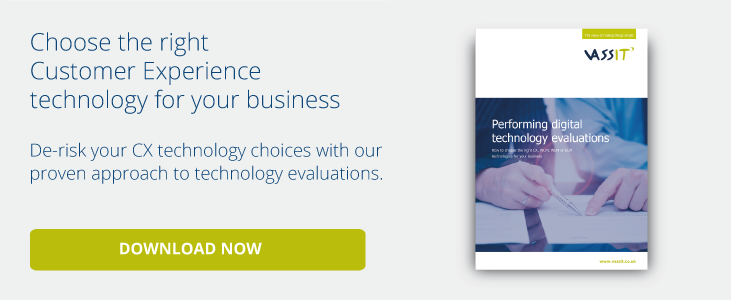Upgrading enterprise technology systems is an expensive process, and organisations that don't do their due diligence are likely to suffer dire and costly consequences. To help mitigate the risk, you can perform technology evaluations before committing to a purchase – but what exactly should you be assessing?
1. Does it Fit Your Needs?
Although this point might be obvious to many readers, the history of enterprise IT is littered with the skeletons of disastrous transformation projects that could have been saved by somebody simply asking, “Is this really what we need?”
You can avoid such a fiasco by working with the appropriate stakeholders to define exactly what your organisation does need, and, comparing how proposed solutions measure up to that baseline. You should also try to consider how your needs might change with business growth, although nobody is expecting you to make perfect predictions.
It’s often a struggle to find products that fit all your requirements out of the box, so we recommend working closely with your technology provider to procure custom solutions. Custom configuration and deployment will likely be more expensive, but it should provide access to technology pilots, proofs of concept and demo installs – helping you find the perfect fit for your business.
2. How Does it Interact with Your current Infrastructure?
Although you might want to tear up your entire IT infrastructure and start fresh, it’s very rare that businesses are able to do this. Instead, it's likely you'll be transforming your systems piece by piece, so it’s vital to remain mindful of how any new technology will interact with your existing architecture.
For example, if your organisation currently relies heavily on Microsoft hardware, purchasing a new Apple software solution isn’t in your best interest. Similarly, you don’t want to find yourself in a situation where your subsystems use many different data formats. levels of compliance or methods of authorisation.
but unless you're following an already existing technology road-map, it's unlikely you’ll be upgrading to systems that slot seamlessly into your existing infrastructure – especially if you're making a first foray into cloud-based products.
Organisations thinking of upgrading IT systems in the not-too-distant future need not despair though, systems integration can help connect new technology. However, you should be still mindful that the less compatible a new solution is, the more complicated, expensive and time-consuming the project will be.
3. Are Your Employees Ready to Adopt New Technology?
As well as evaluating how compatible new technology is with your existing systems, it’s also vital you assess how it interfaces with the fleshy human element of your organisation’s infrastructure. Simply put, there’s very little point in upgrading your systems if nobody is actually able to operate them.
Obviously, we don't suggest your businesses remains stationary, but you’ll need to have a plan in place to empower your workforce with the required training, without impacting productivity.
4. Is Your Business Ready to Move to a New System?
Upgrading your IT systems isn’t as simple as plugging something in, turning it on and getting started. As we’ve already illustrated, you need to ensure employees are able to use the new technology and that it doesn’t clash with your existing infrastructure – but that's not all.
You’ll also need to plan how you'll migrate from the old system. Here there are two main issues to address:
- Will the new system be able to access all the data it needs?
- Does the new solution replicate all the functionality provided by your old system?
The last thing your organisation needs is to complete an upgrade only to discover you're missing essential data that was stored solely in an outgoing piece of hardware, or, that the software you've replaced performed a secondary function that simply isn't achievable using your new systems.
Failing to address these issues will not only affect your business’s ability to operate, it will directly affect the cost and timescale of the deployment. And, ultimately, how quickly you see a return on your investment.
5. Can You Afford it?
Any senior IT professional understands the pain of trying to put together a budget proposal for a systems upgrade, not least because trying to put a figure on the potential ROI of a new piece of enterprise technology is almost an art-form in itself.
When evaluating any potential IT implementation, you’ll also need to accurately predict the cost and timescale required for each element of the project or you’ll struggle to avoid exceeding your budget. Unfortunately, calculating the cost of ownership goes far beyond just the purchase price of your chosen solution, with plenty of additional charges you need to account for, including:
- Deploying, configuring and customising your solution to meet your specific needs
- The cost of any systems integration project
- Operating costs, including the cost of support and maintenance
- The cost of any training your employees will require
Unless you’re certain that the entire project, from design to go-live, fits your budget with a little wiggle room for delays and complications, you should consider rethinking the proposed solution or discussing ways to reduce costs with your provider.
Can You Confidently Perform A Thorough and Complete Technology Evaluation?
Performing a technology evaluation is no small undertaking and getting it right requires significant time, effort and knowledge. For many businesses there is little margin for error and the consequences of pursuing the wrong technology are often grave.
To help ease the pressure on themselves, an increasing number of organisation are looking externally for assistance with technology evaluations. Partnering with a systems integrator will not only relieve you of the effort needed to analyse each technology, but, providing you select the right partner, you’ll also benefit from:
- Objectivity about the systems being considered
- Prior understanding of technologies and implementations
- Previous experience working with providers and vendors
- Expert knowledge on spotting potential pitfalls
- An analytical and data-driven approach to technology evaluation
At VASSIT we understand that upgrading enterprise technology isn’t a quick or easy task. That's why our objective and impartial evaluation system has been developed to ensure businesses have all the information required to make an informed decision. You can find out more about our robust evaluation methodology by reading our ebook - Performing Digital Technology Evaluations.



